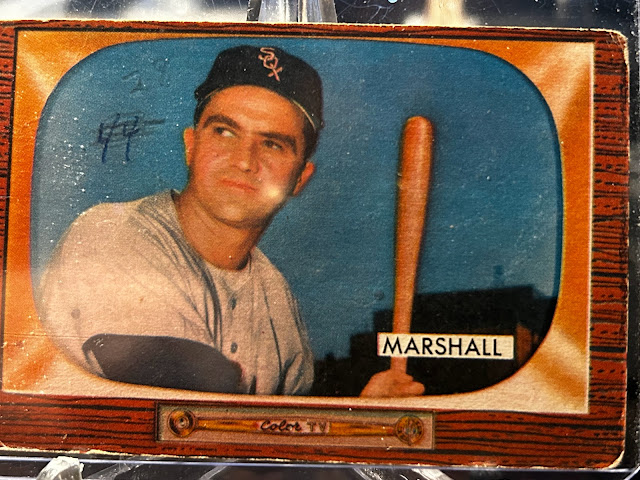Some behind the scenes before we go into this post. I typically use two sources for most of my information: Baseball Reference and Wikipedia. If I find something interesting in one of those two places, I will usually do some more research to try and tell a more interesting story. This time, I had to do research for the completely opposite reason.
 |
| As is the norm with these cards that people wrote on: Marshall wore neither #44 nor #28 |
By the numbers on Baseball Reference, Marshall had a solid career. He was a 3-time all-star over 11 seasons, and he never played in a post-season series. His Wikipedia page is 10 sentences long, and basically just summarizes his stats. So I had to dig a little bit more just to find interesting facts, but I did find a couple (thanks to SABR for a well-written biography).
Marshall was born in Virginia, and went to college at Wake Forest in North Carolina. During his sophomore season, he began playing semi-pro baseball for the Atlanta Crackers. Eventually, word about his great power spread and the Brooklyn Dodgers almost bought his contract... until the attack on Pearl Harbor happened. Apparently, a 6'1" 195 lb. 21-year old was seen to be prime draft material, so the Dodgers backed off of their pursuit.
Eventually, the New York Giants purchased him from the Crackers, and he had a sensational start to his rookie season, hitting 6 home runs in his first 29 games. He was such a fan favorite, that he made the All-Star team. Unfortunately, he could not keep that momentum up, and only hit 11 home runs in 116 games for the season.
Then World War II came calling, and Marshall spent the next 3 years in the Marines in a quartermaster unit (basically supervising barracks and distributing provisions).
When he returned, he picked up where he left off. In 1946 he hit .282 with 13 home runs. Then in 1947 he had his best season. He hit an impressive 36 home runs with a .291 average, which was third highest in all of baseball. He was an All-Star again, and finished 16-th in MVP voting.
Unfortunately for Marshall, he lost his swing after this season, and never regained his power numbers. He hit .307 in 1949 and reached his 3rd and final All-Star team, but with only 12 home runs.
He did play the entire 1951 season in the outfield without making an error, at the time it was only the second time that had happened.
After three seasons with the Boston Braves, a season and a half with the Cincinnati Redlegs, and two seasons with the White Sox in a greatly reduced role, Willard Marshall retired from baseball after the 1955 season.
As I stated before, he made 3 All-Star teams in his 11-year career, hit .274 with 130 home runs and 604 RBIs.
As I stated before, he made 3 All-Star teams in his 11-year career, hit .274 with 130 home runs and 604 RBIs.
After his career, Marshall was a scout for the New York Giants, he worked for his wife's real estate business, and was the director of recreation for Fort Lee, New Jersey for 25 years. Marshall passed away on November 5, 2000 at the age of 79. He is buried in Fairview Memorial Park in Fairview, New Jersey.

Comments
Post a Comment